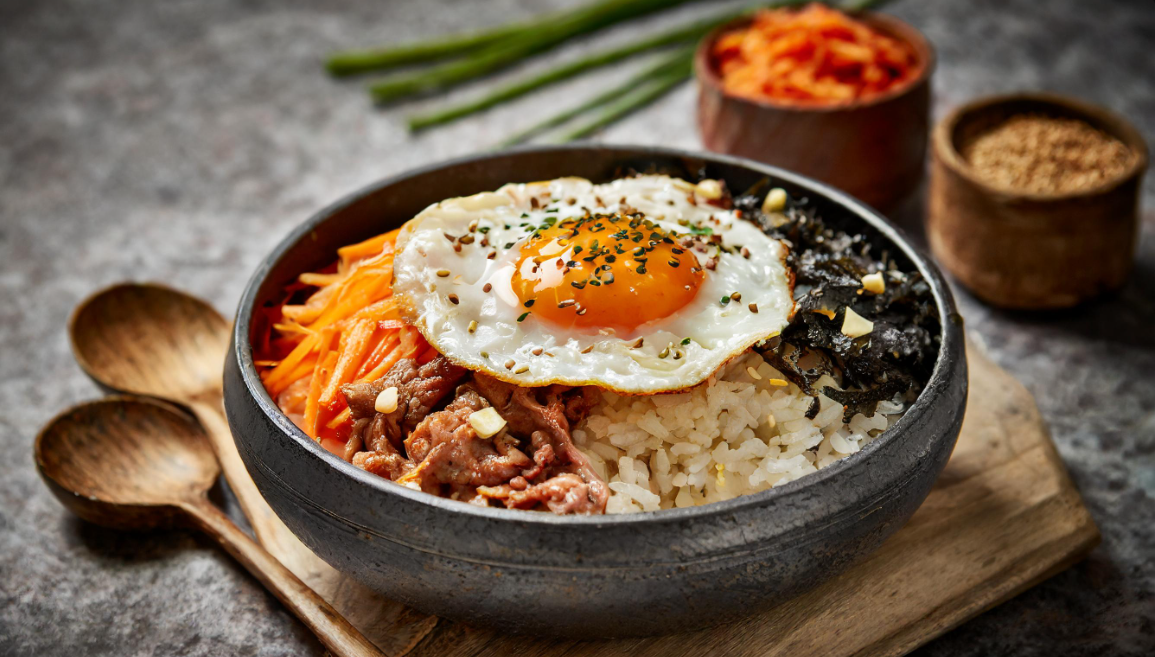Introduction:
Take a culinary journey to Korea with this delicious Bibimbap recipe. Bibimbap, which means “mixed rice” in Korean, is a popular dish known for its bright colors, powerful flavors, and harmonious combination of ingredients. This popular Korean dish is both a culinary and visual joy, including a bright array of vegetables, protein, and a delicious sauce served over a bed of steaming rice.
Join us as we explore the complexities of making the perfect Bibimbap, encouraging you to experience the spirit of Korean food in your own home.

Bibimbap Ingredients:
For the Bibimbap Bowl:
- 2 cups cooked short-grain rice
- 1 cup spinach, blanched
- 1 cup bean sprouts, blanched
- 1 cup shredded carrots, sautéed
- 1 cup sliced shiitake mushrooms, sautéed
- 1 cup julienned cucumber
- 1 cup thinly sliced beef (or tofu for a vegetarian option), marinated
- 4 eggs
- Sesame oil for drizzling
- Sesame seeds for garnish
- Salt and pepper to taste
For the Bibimbap Sauce:
- 4 tablespoons gochujang (Korean chili paste)
- 2 tablespoons soy sauce
- 2 tablespoons rice vinegar
- 1 tablespoon sesame oil
- 1 tablespoon honey
- 2 cloves garlic, minced
- 1 teaspoon grated ginger
- 1 teaspoon sesame seeds

Step-by-Step Bibimbap Recipe:
Step 1: Prepare the Ingredients:
- Cook the short-grain rice according to package directions and set aside.
- Blanch the spinach and bean sprouts for 1-2 minutes in boiling water, then drain and rinse with cool water. Squeeze any extra water from the spinach and bean sprouts.
- Cook the shredded carrots and sliced shiitake mushrooms separately in a pan with a little oil until soft. Season with salt and pepper to taste.
- For at least 30 minutes, marinate thinly sliced beef (or tofu) in soy sauce, sesame oil, chopped garlic, grated ginger, and a pinch of pepper.
Step 2: Prepare the Bibimbap Sauce:
- In a small bowl, mix together gochujang, soy sauce, rice vinegar, sesame oil, honey, chopped garlic, grated ginger, and sesame seeds.
- Mix thoroughly until the sauce is smooth and properly mixed. Adjust the seasoning to your taste.
Step 3: Cook the Eggs:
- Heat a nonstick pan over medium heat and crack the eggs into it.
- Cook the eggs sunny-side up or according to your liking, keeping the yolks runny.
Step 4: Assemble the Bibimbap Bowls:
- Distribute the cooked rice evenly amongst serving bowls.
- Place blanched spinach, bean sprouts, sautéed carrots, shiitake mushrooms, julienned cucumber, and marinated beef (or tofu) on top of the rice in separate portions.
- Put a cooked egg on top of each bowl.
Step 5: Drizzle with Bibimbap Sauce and Garnish:
- Pour a generous amount of Bibimbap sauce into each bowl, focusing on the contents.
- For added taste, drizzle some sesame oil over the top.
- Add sesame seeds as a finishing garnish for texture and visual appeal.
Step 6: Mix and Enjoy:
- To eat Bibimbap, use a spoon or chopsticks to completely combine all of the ingredients and sauce.
- Make sure the rice, vegetables, protein, and sauce are uniformly distributed to achieve a balanced blend of flavors and textures.
- Serve immediately and enjoy the delicious flavors of Bibimbap!

Additional Tips for Perfect Bibimbap recipe:
Bibimbap is traditionally made with short-grain rice, which has a slightly sticky texture that helps to bind the contents together. For the most realistic Bibimbap experience, use short-grain rice.
Preparing Ingredients in Advance: Because bibimbap has multiple components, it’s a good idea to prepare them ahead of time, such as blanching veggies, marinating pork (or tofu), and creating the sauce. This saves time and promotes a more efficient cooking procedure.
Keep contents Separate: When making Bibimbap bowls, place the contents in separate areas on top of the rice. This not only enhances the dish’s visual appearance, but also allows guests to customize the ingredients to their liking.
Don’t Overcook Vegetables: Blanch them briefly to keep their brilliant colors and crisp texture. Overcooking can cause mushy vegetables, which detracts from the overall presentation and flavor of the dish.
Adjust the spice level: The spiciness of gochujang, the Korean chili paste used in bibimbap sauce, varies. Taste the sauce and adjust the amount of gochujang to your spice level. For added spice, add a pinch of Korean chili flakes (gochugaru).
Experiment with Protein: While traditional Bibimbap is made with thinly sliced beef (bulgogi), you can use chicken, pig, fish, or tofu for a vegetarian option. Make sure the protein is fully marinated and cooked to perfection.
Bibimbap is frequently garnished with fresh vegetables such as cucumber, lettuce, or Korean perilla leaves (kkaennip). These provide a refreshing crunch and counterbalance the richness of the remaining components.
Serve Bibimbap with Kimchi, a popular Korean fermented vegetable dish. Kimchi lends a sour and spicy bite to the meal, matching the tastes of Bibimbap perfectly.
Drizzle with Sesame Oil: Finally, drizzle sesame oil over the completed Bibimbap bowls to accentuate the nutty scent and offer a subtle depth of flavor. To make the dish more flavorful, use toasted sesame oil.
Enjoy the Mixing Process: One of the highlights of eating Bibimbap is combining all of the ingredients before taking a bite. Encourage customers to completely combine the rice, vegetables, protein, and sauce to create a symphony of flavors and textures in each mouthful.
With these suggestions, you’ll be well-prepared to produce a tasty and authentic Bibimbap experience that captures the essence of Korean cuisine. Whether you’re cooking for yourself or hosting a dinner party, Bibimbap will dazzle with its rich flavors, brilliant colors, and adaptability.

Conclusion:
With this thorough Bibimbap recipe, you can replicate the unique flavors of Korea in your own kitchen. Every component of this dish, from the vibrant variety of fresh veggies to the savory marinated beef (or tofu) and the powerful flavors of the Bibimbap sauce, is intended to tickle your taste buds and transport you to Seoul’s bustling streets.
Whether you’re an experienced cook or a beginner, this step-by-step tutorial will help you master the art of Bibimbap and impress your family and friends with a tasty and gratifying meal. So gather your supplies, unleash your culinary imagination, and experience the culinary wonders of Bibimbap!
You might also like: Chicken Lollipop Recipe: How to Make Crispy and Juicy Chicken Lollipops at Home
- Preparing Ingredients in Advance
- Keep contents Separate
- Don’t Overcook Vegetables
- Adjust the spice level
- Serve Bibimbap with Kimchi
- Drizzle with Sesame Oil
Take a culinary journey to Korea with this delicious Bibimbap recipe. Bibimbap, which means “mixed rice” in Korean, is a popular dish known for its bright colors, powerful flavors, and harmonious combination of ingredients. This popular Korean dish is both a culinary and visual joy, including a bright array of vegetables, protein, and a delicious sauce served over a bed of steaming rice.

Pingback: Classic Mimosa Recipe: Sparkling Refreshment for Brunch 2024